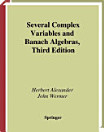Potential Theory
juni 2013 · Springer Science & Business Media
E-bok
149
Sidor
reportBetyg och recensioner verifieras inte Läs mer
Om den här e-boken
Potential theory grew out of mathematical physics, in particular out of the theory of gravitation and the theory of electrostatics. Mathematical physicists such as Poisson and Green introduced some of the central ideas of the subject. A mathematician with a general knowledge of analysis may find it useful to begin his study of classical potential theory by looking at its physical origins. Sections 2, 5 and 6 of these Notes give in part heuristic arguments based on physical considerations. These heuristic arguments suggest mathematical theorems and provide the mathematician with the problem of finding the proper hypotheses and mathematical proofs. These Notes are based on a one-semester course given by the author at Brown University in 1971. On the part of the reader, they assume a knowledge of Real Function Theory to the extent of a first year graduate course. In addition some elementary facts regarding harmonic functions are aS$umed as known. For convenience we have listed these facts in the Appendix. Some notation is also explained there. Essentially all the proofs we give in the Notes are for Euclidean 3-space R3 and Newtonian potentials ~.
Betygsätt e-boken
Berätta vad du tycker.
Läsinformation
Smartphones och surfplattor
Installera appen Google Play Böcker för Android och iPad/iPhone. Appen synkroniseras automatiskt med ditt konto så att du kan läsa online eller offline var du än befinner dig.
Laptops och stationära datorer
Du kan lyssna på ljudböcker som du har köpt på Google Play via webbläsaren på datorn.
Läsplattor och andra enheter
Om du vill läsa boken på enheter med e-bläck, till exempel Kobo-läsplattor, måste du ladda ned en fil och överföra den till enheten. Följ anvisningarna i hjälpcentret om du vill överföra filerna till en kompatibel läsplatta.





